
The planning application for social housing at Balmaha on a site designated as Ancient Woodland raises some major issue (see here) which I hope to return to before it is considered by the Loch Lomond and Trossachs Planning Committee. Meantime, in order to understand the application, it needs to be considered within the wider context of land-use at Balmaha.
Since the National Park came into existence in 2002 Balmaha has been transformed into an upmarket tourist accommodation village rather than a place for people to live or, indeed, somewhere that people with less money in their pockets can stay. This is happening because of planning decisions by the National Park.
The site of the former Highland Way hotel
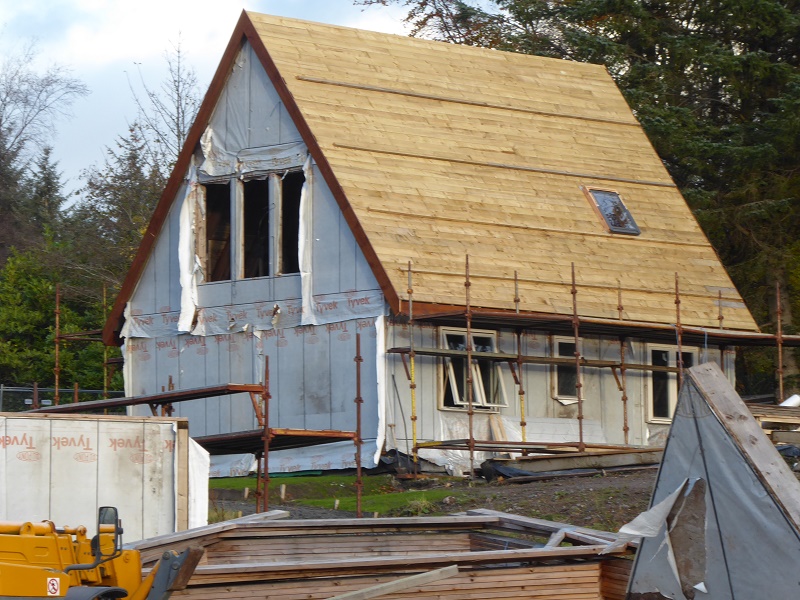
The former Highland Way hotel, situated across the road from the Oak Tree Inn, closed in 2006 and a planning application for a Bar Restaurant and 13 holiday cottages on the east part of the site was approved in 2008. The McKever Group, which owned it, went into administration in 2009 but only, as far as I have been able to ascertain, after demolishing it – leaving a wrecked site. Wayne Gardner Young, the entrepreneur who moved into the former bunkhouse (top photo) and who had had grand plans with the LLTNPA for the West Riverside site in Balloch then acquired the eastern part of the site for a bargain price (see here).
In 2011 Wayne Gardner Young joined forces with Sandy Fraser, the owner of the Oak Tree Inn, who owned the land to the west of Balmaha House (where there is still a 14 place bunkhouse, the last place in the village providing basic accommodation). Sandy Fraser had previously had a planning application for a shop and bunkhouse on the western part of the site approved but this had lapsed in 2009. Together they submitted a planning application for a single development including 24 chalets covering both parts of the site in 2011. This then stalled, although this did not stop Wayne Gardner Young from building foundations for a number of buildings and erecting a luxury lodge in 2014, all without planning permission being approved.
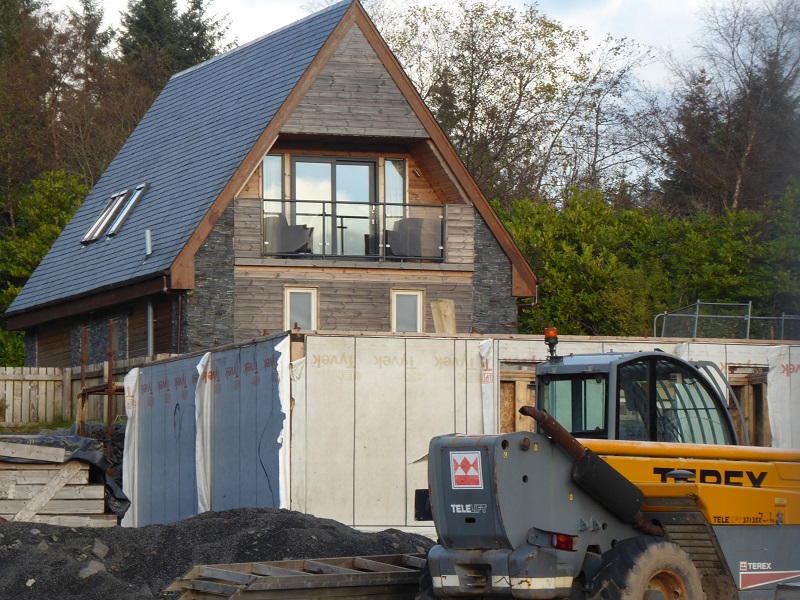
Mr Gardner Young then applied for retrospective planning permission (2014/0238/DET) for this building – photo above – describing it as a storage shed. There is a good explanation of all of this in the report to Planning Committee in 2016:
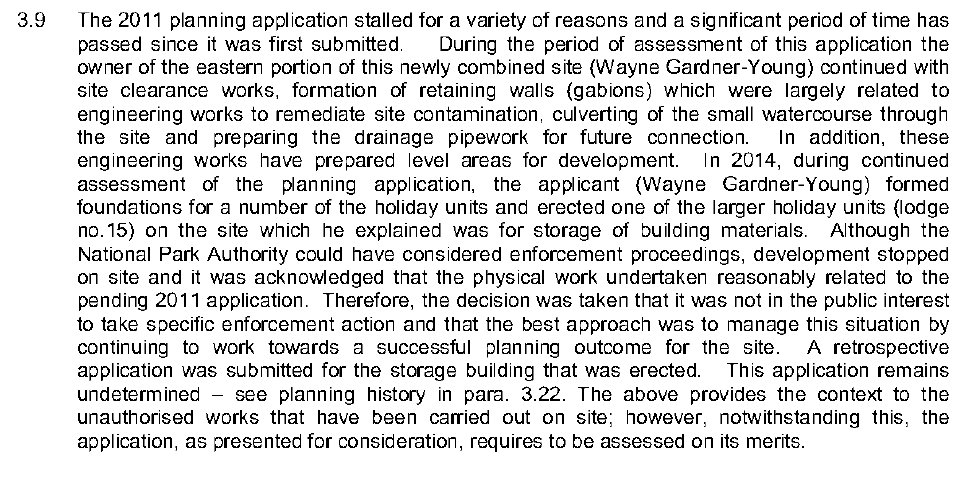
In 2016 Sandy Fraser and Wayne Gardner Young submitted a revised application for the site, which included a restaurant, smokehouse and micro brewery and 20 Lodges, four less than the previous application.
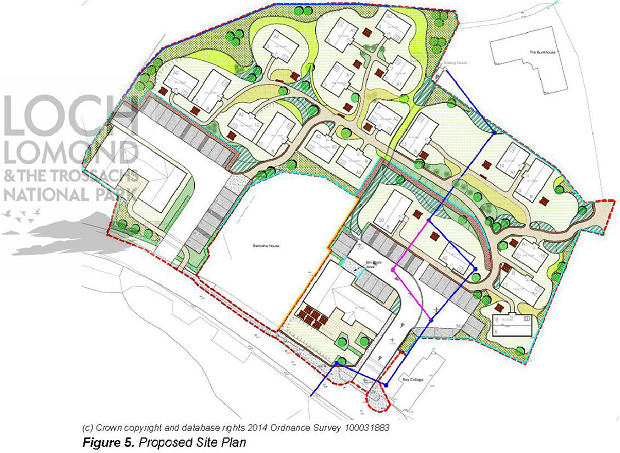
The Buchanan Community Council objected, for a number of reasons, including:
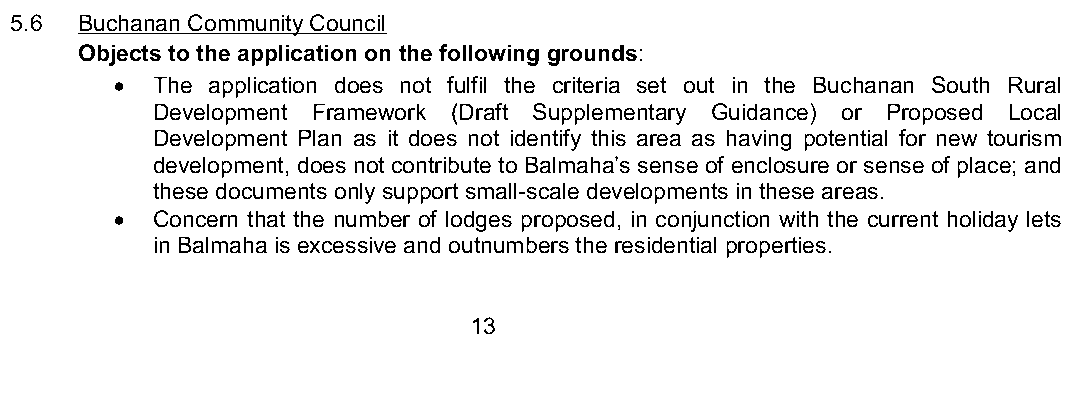
Its worth reading the Committee Report (see here) to see just what convoluted arguments the LLTNPA used to try and show that the development was in accordance with its development plan (pages 14-25). None of the negotiations that took place with Wayne Gardner Young and Sandy Fraser are published on the planning portal so its only conjecture what happened but it appears that LLTNPA officers did try (they had got the development slightly reduced in size and also agreement to create a public path going through it) before recommending approval.
I won’t dwell here on the failure by the LLTNPA to take enforcement action in this case. Development in Balmaha increasingly appears to be a free for all and a significant percentage of all planning applications appear to be made retrospectively (there is a fantastic project to be had on the history of planning in the village since the creation of the National Park). The key point in relation to housing and use of space in the village is that the development includes 20 new holiday lodges and just two flats for staff accommodation above the restaurant. The Committee Report failed totally to consider whether these were sufficient for all the new staff required for the business and the LLTNPA made no requirements for residential accommodation to be provided on site. There are parallels with the even bigger Torpedo site development at Arrochar which was supposed to create 300 jobs (see here) also without adequate provision for new accommodation for workers to live in the village. The situation in Balmaha has been made worse because the LLTNPA made it a condition of the planning approval that none of the 20 tourist lodges could be occupied permanently, in other words none could be used to house staff or people working in other businesses. A great lesson in how to create an instant housing shortage.
The decision at the Highland Way Hotel site though simply worsens what was already a severe housing shortage, to which at least two other tourist accommodation developments have made significant contributions.
The Oak Tree Inn
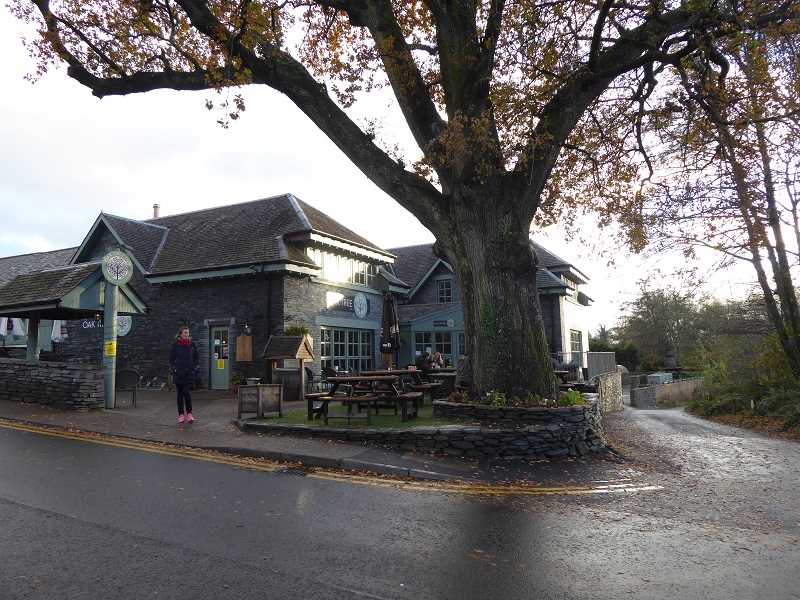 The Oak Tree Inn, which is run by Sandy Fraser’s family, does not just provide accommodation in the Inn – certain modifications to which had planning permission agreed retrospectively in 2010 – it also provides accommodation in a number of houses on the south side of the B837 which is currently advertised at between £80 (for a single room) and £165 a night.
The Oak Tree Inn, which is run by Sandy Fraser’s family, does not just provide accommodation in the Inn – certain modifications to which had planning permission agreed retrospectively in 2010 – it also provides accommodation in a number of houses on the south side of the B837 which is currently advertised at between £80 (for a single room) and £165 a night.
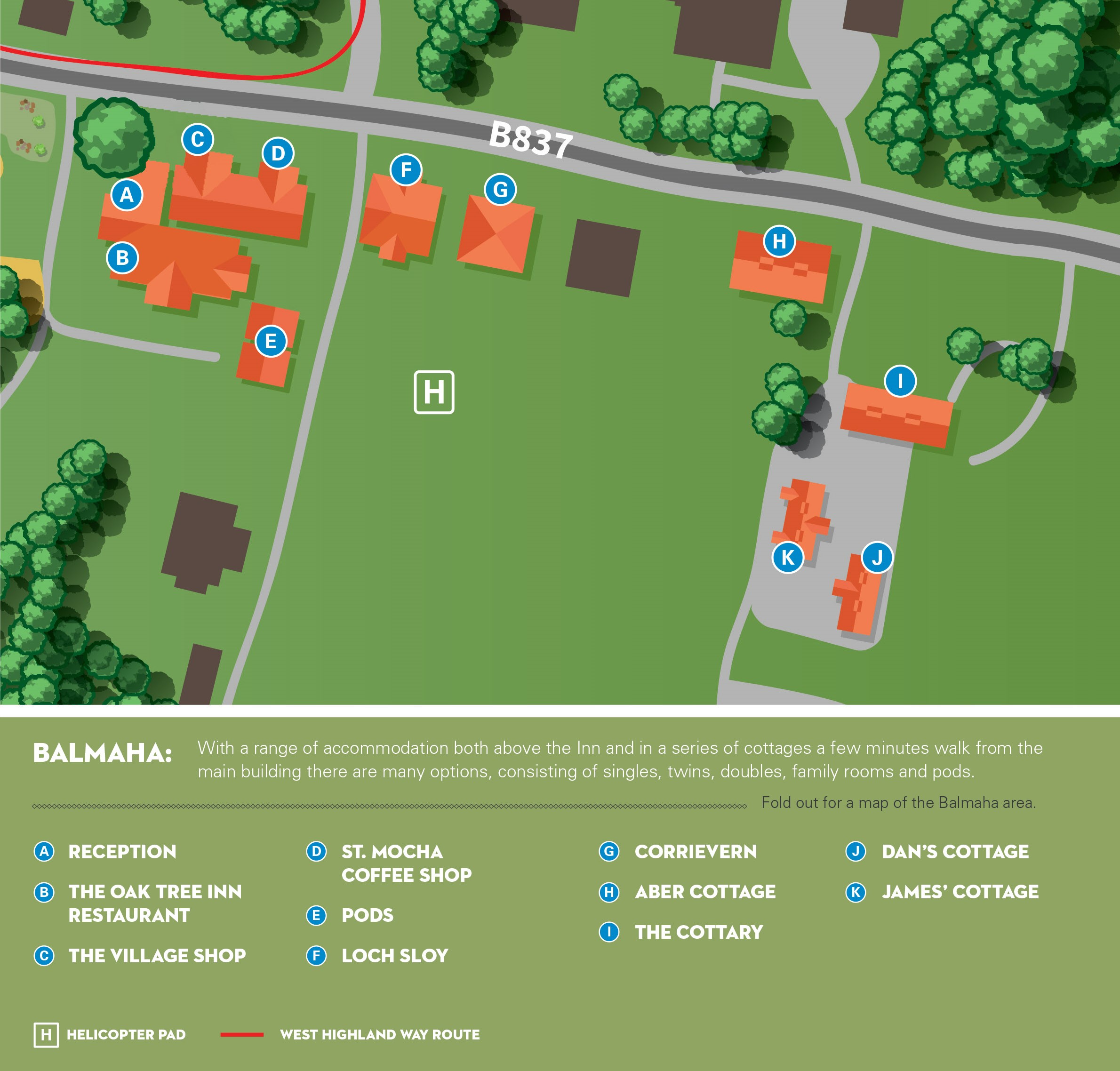
It appears this accommodation is in effect an adjunct to the Inn and, while I cannot find any planning applications that cover this, perhaps planning permission was not required? Whatever the case, another section of the village appears devoted to the provision of luxury holiday accommodation.
Balmaha Waterfront
The third large existing tourist development in Balmaha is called the Waterfront and provides another 11 Holiday Lodges as well as a function centre (on what used to be a garden centre there). Planning permission for this was agreed back in 2004 on condition that the site was concealed behind new woodland planting. The owners have recently in 2017, having apparently failed to deliver the conditions of that planning permission (the site is highly visible from the road), applied to have it varied.
The cumulative impact of “luxury” tourist accommodation in Balmaha
As well as the three developments described above, the LLTNPA in 2011 approved the development of 19 holiday chalets behind the National Park Visitor Centre subject to a legal agreement. Had this gone ahead it would have altered the proportion of tourist to residential accommodation even further. Local objectors to the proposal to build social housing on the designated Ancient Woodland Site believe this should be used to provide the social housing. The site is, however, not on the market and strangely it did not appear in the Local Development Plan unlike the Ancient Woodland Site. Its not clear therefore what plans, if any, exist for it. A case for a community buyout perhaps?
As a consequence of all these tourist developments, none of which appear to have made adequate provision for the workforce which services them, there is a housing crisis in Balmaha. The LLTNPA half acknowledged this this back in 2014 in its charrette report for Balmaha (see here) which informed the local development plan:
This acknowledgement did not stop the LLTNPA approving the Highland Way site development, creating further imbalance, but by then they knew Forest Enterprise and the Stirling Rural Housing Association were riding to the rescue with the woodland site. Because of the local housing shortage its not surprising that there has been strong support from people who work within the area that they should be provided with somewhere to live locally. Its these people who appear to have turned up to the Buchanan Community Council meeting earlier this year and got them to agree to support the proposal to build social houses on the ancient woodland site. One wonders, if they had been given a choice of site, whether they would have still supported the proposal currently on the table?
What appears to be happening in Balmaha in terms of spatial planning is that the provision of social housing is being shunted to the fringes of the village, rather than being integrated with tourist accommodation and other housing. Maybe rich visitors and residents prefer most of the workforce to remain out of sight? The Park’s decision making process however has also benefitted the new lairds pockets. Instead of having to make provision for housing the workforce they need to service their developments on their own land, which would incur significant costs, the public sector is doing this for them. Another case of the “taxpayer” subsidising business. This happens in towns too of course but, in a small place like Balmaha, which is geographically isolated it becomes much more obvious.
Balmaha – a tale of developing social segregation and exclusion
What’s happening in Balmaha is not just about segregation of workforce and visitor, its about the type of visitor the village caters for too. Balmaha is a prime stopping off point for walkers on the West Highland Way, the natural end point to the first day for fitter walkers setting out from Milngavie. Yet it has no campsite, and despite all the flat ground, and representations to the LLTNPA, there are NO plans for one. Bunkhouse accommodation is now minimal. To make matters worse, the camping byelaws have been extended on east Loch Lomond, making it even harder to camp. LLTNPA Rangers now, not surprisingly, spend much time chasing campers away from the village.
Meantime Sandy Fraser has been one of the most vocal public supporters of the camping byelaws on east Loch Lomond (see here). In that interview he claimed campers intimidated other visitors when actually, most campers did nothing of the sort and those that did could have been moved on or charged by the police. A few more may have left litter but how did that compare with the eyesore on the land he owned in the centre of the village? One law for the lairds, another for everyone else.

The entrance to the site Sandy Fraser owns tells another tale. Park Rangers walked past this for years – its clearly against the Scottish Outdoor Access Code – but they and their bosses did nothing.
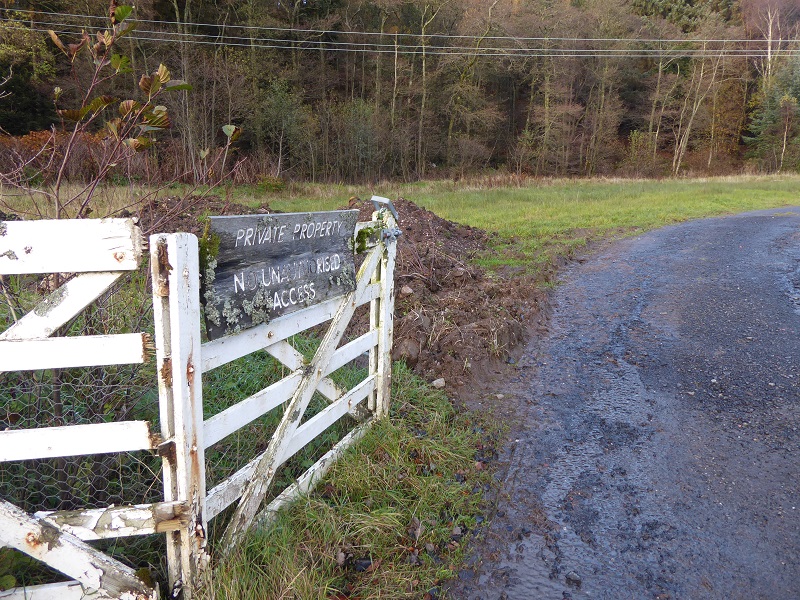
I don’t know if the caravans in the upper photo are still there – they might have been removed once work started on the development – but if anyone was still staying in them, they could now be committing a criminal offence under the camping byelaws. I am not sure Sandy Fraser or others in the local community appreciated this when they agreed to remove their opposition to the repeal of the existing Loch Lomond byelaws at their meeting in January: the old byelaws had allowed locals to put up tents and sleep in vehicles within the curtilage of their buildings. Still, the Park Chief Executive, Gordon Watson is recorded in the minute of that meeting as saying the new byelaws were better and it appears people believed him.
The new version of the byelaws makes sleeping overnight in a vehicle – and a caravan is classified as a vehicle as I understand it – in a camping management zone a criminal offence unless its on a road or is done by the landowner, their immediate family or a tenant with a lease of a year or more. Landowners can no longer allow people to sleep in vehicles or put up tents in their own gardens. The gate sign appears to indicate Sandy Fraser thought there was no public right of passage here (a private road is only classed as a road under the Road Traffic Act 1984 if there there is a public right of passage along it). So, anyone apart from Sandy Fraser and his family, or a long term tenant, staying in a caravan on this development site would be committing a criminal offence unless they been granted an exemption by the National Park.
One good thing perhaps about the camping byelaws? They could highlight which tourism accommodation providers are not housing their workforce properly. (They should be checking every caravan in the Park that appears to be being used for housing purposes and forcing them to apply for exemptions).The likelihood of the LLTNPA ever enforcing this though appears small – the byelaws would probably collapse
The whole story of the Highland Way Hotel and other tourist accommodation sites in Balmaha shows how little power the LLTNPA has over the new lairds. Or perhaps its the other way round? It maybe shows how much power the new lairds have over the Park Authority.

1 Comment on “Land-use, the new lairds of Balmaha and the camping byelaws”